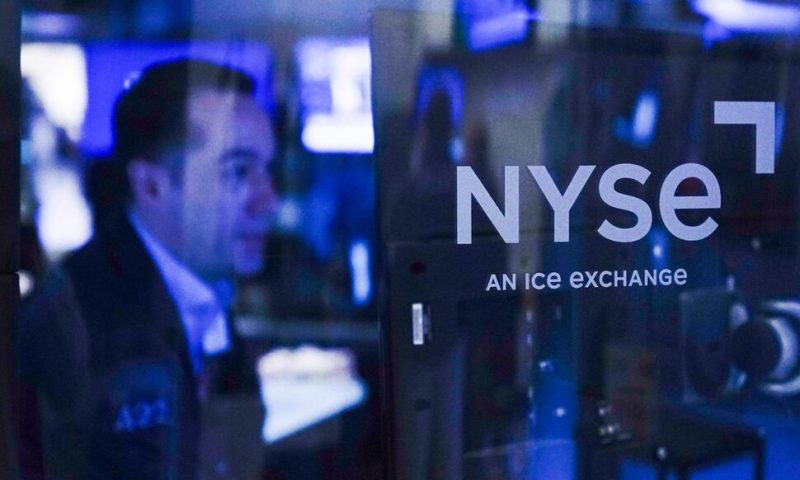Wall Street fell for a third straight day as rising yields in the bond market keep cranking up the pressure
NEW YORK — Wall Street fell for a third straight day Thursday as rising yields in the bond market keep cranking up the pressure.
The S&P 500 sank 33.97, or 0.8%, to 4,370.36, and August is on track to be its worst month of the year by far. The Dow Jones Industrial Average dropped 290.91 points, or 0.8%, to 34,474.83, and the Nasdaq composite fell 157.70, or 1.2%, to 13,316.93.
The losses were widespread. Some of the hardest hit were high-growth stocks seen as the most vulnerable to higher interest rates. Meta Platforms sank 3.1%, and Tesla dropped 2.8%. Apple fell 1.5% and was the heaviest weight on the S&P 500.
Stocks broadly have been retreating in August following a torrid first seven months of the year. That’s in part because a swift rise in bond yields is forcing a reassessment of how much to pay for stocks.
The 10-year Treasury, which is the centerpiece of the bond market, is now yielding 4.28% after touching its highest level since October in the morning.
If it reaches 4.34%, it will be at a level unseen since 2007, according to Tradeweb. That’s before the financial crisis and Great Recession caused yields to collapse to record lows. The 10-year Treasury was yielding less than 0.70% three years ago.
Higher yields are good for bond investors, who get fatter payouts for their investments. But it hurts stock prices because investors are suddenly less inclined to pay high prices for them and other investments that aren’t as steady as bonds.
Higher yields also mean borrowers have to pay more to get cash, which can crimp corporate profits and cause unforeseen things to break in the system, like the three high-profile U.S. bank failures that shook markets this spring.
Homebuyers are feeling the sting. The average rate on a 30-year mortgage hit its highest level this week in more than 20 years.
Yields have been on the rise as more reports show the U.S. economy remains remarkably resilient. On the upside for markets, the data means the economy has been able to avoid a long-predicted recession. But on the downside, it could also keep upward pressure on inflation. That would give the Federal Reserve reason to keep interest rates higher for longer.
More data came in Thursday showing a firm U.S. economy.
Fewer workers applied for unemployment benefits last week than economists expected. It’s the latest signal that the job market continues to be solid.
A survey of manufacturers in the mid-Atlantic region also unexpectedly showed growth, when economists were expecting another month of contraction. Manufacturing has been one of the areas of the economy hit hardest by much higher interest rates.
“The labor market continues to be resilient—maybe too resilient for the Fed’s liking,” said Mike Loewengart, head of model portfolio construction at Morgan Stanley Global Investment Office.
Other strong economic data recently, including a report showing an acceleration in sales growth at U.S. retailers, mean the Fed could hike interest rates again at some point, he said. Hopes had been rising on Wall Street that the Fed could be done after it raised its main rate last month to the highest level in more than two decades.
Traders had also been hoping the Fed would begin cutting rates early next year. Such a move would be a relief for markets because high rates work to lower inflation by slowing the entire economy and hurting prices for investments.
Minutes from the Fed’s latest meeting released Wednesday suggested officials are unsure of their next move. They say it will depend on what upcoming reports about inflation and the job market say.
Inflation has cooled considerably from its peak above 9% last summer. But consumers still paid prices that were 3.2% higher in July than a year earlier, and economists say the last stretch to get inflation down to the Fed’s 2% target may prove to be the most difficult.
A stronger economy would burn more fuel, and oil prices rose Thursday to recover some of their slide from earlier in the week. That helped propel stocks of energy producers to some of the rare gains within the S&P 500.
Exxon Mobil rose 1.9%, and ConocoPhillips gained 1.8%.
Cisco Systems was a bright spot within the tech sector, rising 3.3%. The maker of networking equipment reported stronger profit and revenue for the latest quarter than analysts expected.
Walmart likewise topped expectations, while raising its forecast for full-year results. But its stock swung from an early gain to a loss of 2.2%.
In stock markets abroad, indexes fell across much of Europe and Asia.
Worries about a faltering economic recovery in China have weighed on stocks in Hong Kong and Shanghai in particular recently, though they were steadier Thursday.

